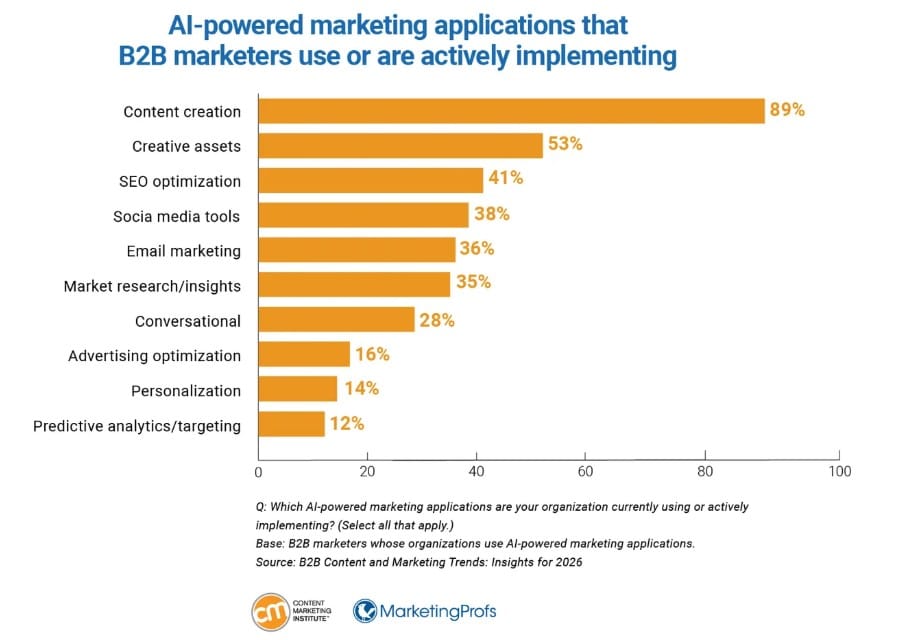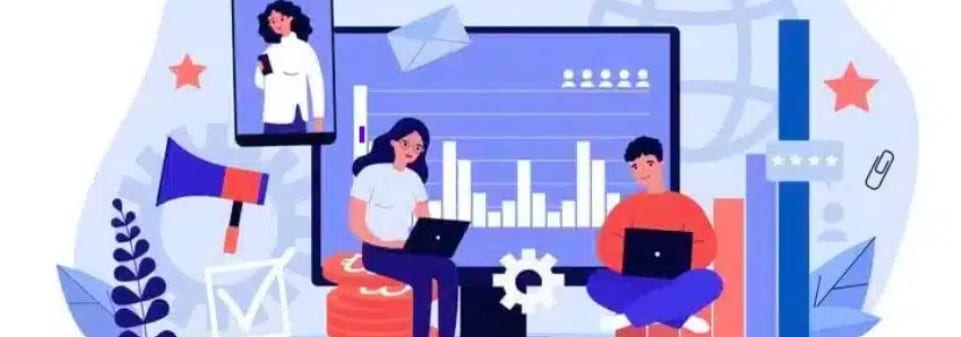B2B marketing is changing fast, and if you’re building a startup, you’ve probably noticed how different things feel compared to just a few years ago. The usual methods don’t bring the same results anymore; buyers are more careful, competition is tougher, and standing out now takes more than smart ads or headlines.
In 2026, growth comes from clarity and connection. You need to know exactly who you’re speaking to, what problems they care about, and how your product fits into that picture. The startups that get this right are the ones building stronger brands and growing steadily.
This guide shares 9 proven strategies that will work in 2026—real, data-backed approaches designed to help you grow smarter and stand out where it matters most.
Understanding B2B Marketing Strategy
A B2B marketing strategy is your plan for attracting, engaging, and converting other businesses into loyal customers. Unlike B2C marketing, where you sell directly to individual consumers, B2B marketing focuses on building long-term relationships with decision-makers and entire buying committees.
In simple terms, it’s the plan that helps you connect your solution to the real problems your target businesses are trying to solve.
A strong B2B marketing strategy usually includes a few key components:

- Clear positioning: You define who you serve, what makes your product unique, and why your audience should care.
- Understanding of your ideal customer profile (ICP): You know your audience’s pain points, challenges, and buying factors.
- Multi-channel presence: You show up consistently where your buyers spend time — whether it’s LinkedIn, industry newsletters, or webinars.
- Data-driven personalization: You use insights and analytics to deliver the right message at the right moment.
- Relationship-building: You focus on creating value first, so sales happen more naturally over time.
For startups, having a solid B2B marketing strategy is especially important. Without it, your efforts can easily become inconsistent.
The State of B2B Startup Marketing in 2026
The B2B marketing space in 2026 looks very different from just a few years ago. Buyers are more informed, sales cycles are longer, and digital channels dominate the journey.
According to Forrester’s 2025 B2B Marketing & Sales Predictions, more than half of large B2B transactions (US$1 million or greater) will be processed through digital self-serve channels, including vendor websites and online marketplaces
Here’s what that means for you as a B2B startup marketer:
- Buyers are self-educating: They research independently, often before talking to sales, meaning your content must guide them early in the process.
- First-party data matters more: With stricter privacy rules, relying on your own data sources has become critical for targeting and tracking.
- Communities and trust drive conversions: Decision-makers trust peers and online communities more than ads or cold outreach.
- AI and automation are reshaping workflows: Around 45% of B2B marketers plan to increase investment in AI tools for personalization and lead scoring.

(Source)
In short, 2026 is about smarter, data-driven marketing, where startups that focus on clarity, value, and relationships outperform those that chase quick wins.
9 Proven B2B Marketing Strategies That Actually Work in 2026
Strategy 1: Define your positioning and ICP before you scale
If you’re a B2B startup, your biggest early advantage isn’t budget, it’s clarity. Before you invest in ads, content, or automation, you need to define who you’re for and why your product matters in a market.
A clear positioning statement and Ideal Customer Profile (ICP) form the foundation of every effective B2B marketing strategy. In 2026, buyers are exposed to dozens of solutions that sound identical. Strong positioning helps you:
- Align your marketing and sales teams around one consistent message.
- Build trust faster by speaking directly to the customer’s specific problem.
According to Gartner, B2B buyers are far more likely to engage with vendors who demonstrate a strong understanding of their business needs and challenges, not just those who talk about product features.
Your ICP goes beyond simple company details like company size or industry. It’s about identifying:
- The problems that trigger a business to look for your solution.
- The decision-makers and influencers are involved in buying.
- The intent signals that show real purchase readiness.
Example 1: Instead of saying “We target SaaS companies,” refine it to “We help early-stage SaaS teams (10–50 employees) struggling to scale inbound leads through content automation.”
Example 2: Instead of saying “We target healthcare organizations,” refine it to “We help mid-sized provider practices (5–15 members) struggling with delayed reimbursements and denial backlogs streamline their medical billing process using automated AR workflows.”
Strategy 2: Build a scalable content ecosystem
Once you’ve defined your positioning and audience, the next step is to build a content ecosystem that drives visibility, trust, and conversions.
In 2026, B2B buyers will rely on content more than ever to make purchase decisions. A scalable content ecosystem isn’t about publishing more; it’s about creating a connected flow where every asset has a purpose.
Each blog, video, case study, or webinar should educate your audience and guide them closer to understanding how your solution fits their needs. Instead of focusing on fresh keyword volume, build content around your audience’s pain points and intent.
For example, if you’re selling workflow automation software, don’t just target “automation tools.” Create content that answers deeper questions like:
- “How to eliminate manual reporting during client onboarding.”
- “How growing SaaS teams save 10+ hours a week with workflow automation.”
And if you’re a B2B startup in the consumables space, selling repeat-purchase items like coffee, snacks, or wellness goods, choosing the right product categories is just as important as your messaging. This breakdown of profitable consumable products to sell online can help you spot evergreen items that lend themselves to recurring orders and long-term customer relationships.
This approach speaks directly to the problems your buyers are trying to solve, which is what truly leads to conversions.
AI can help you scale your efforts, but it shouldn’t replace your unique brand perspective. Tools like can assist with outlining, research, and repurposing, freeing up time for strategy and storytelling.
To make your content even more engaging, you can showcase user-generated or community content directly on your website. With social wall tools like Walls.io, B2B startups can embed a social media feed that highlights authentic posts, customer feedback, or event updates, turning static pages into living proof of engagement and trust.
Strategy 3: Double down on community-led growth
In 2026, one of the biggest shifts in B2B marketing is the move from cold outreach to community-driven growth. Buyers no longer want to be “sold to”; they want to be part of conversations and discover solutions organically through trusted networks.
For you as a startup, that means building or participating in communities where your ideal customers already spend time. Whether it’s an industry Slack group, a LinkedIn collective, or a niche Discord server, communities have become the new ecosystem for awareness and advocacy.
To make community-led growth work for your startup:
- Join existing spaces before you create your own. Participate in niche communities related to your product category. Offer value, answer questions, and build a reputation.
- Create a value-first community when the time is right. Once your brand has credibility, build a space where users can share insights, use cases, and success stories, not just product updates.
- Engage your power users. Encourage satisfied customers to become advocates or mentors inside your community, while AI agents assist in identifying active members and triggering timely engagement prompts. Their stories and contributions will attract more genuine interest than any campaign ever could.
- Integrate your community with your marketing ecosystem. Feature community discussions in newsletters, invite members to co-create content, or host live sessions that educate rather than pitch.
When done right, your community becomes your best growth channel, one that continues to bring in qualified leads even when your ad budget pauses.
Strategy 4: Utilize data-driven personalization
As your startup grows, one of the biggest challenges you’ll face is ensuring that marketing and sales work in alignment, speaking to the same audience, using the same insights, and pursuing the same goals.
Modern B2B buyers expect experiences that feel personalized to them. They don’t want to receive the same generic email sequence as everyone else. According to McKinsey, companies that personalize their buyer experience see up to a 20% increase in conversion rates and higher customer satisfaction scores. For startups with limited budgets, that kind of lift can make all the difference.
Here’s how you can apply it effectively:
- Segment your audience based on intent, not just industry. For example, separate leads who downloaded a product guide (research stage) from those who requested a demo (decision stage).
- Use tools that connect marketing and sales. Platforms like HubSpot or Apollo can automatically sync lead behavior between teams, ensuring both sides act on the same data. Project management tools also help keep marketing and sales aligned by coordinating tasks and workflows.
- Personalize beyond the first name. Customize your outreach around a company’s specific challenge, market segment, or growth stage. A short, thoughtful message often performs better than a long automated sequence. Channels like WhatsApp marketing are also becoming valuable for B2B communication, especially for follow-ups and personalized engagement.
AI tools can take this even further by turning one deck into personalized, interactive versions tailored to each prospect, making outreach feel relevant without adding manual workload.
Strategy 5: Use AI & Automation
AI and automation have become core parts of B2B marketing in 2026, but how you use them determines whether they accelerate your growth or damage your brand.
Artificial intelligence can help you do what used to take hours, segment audiences, analyze buyer intent, or repurpose content, in minutes. But there’s a balance to maintain. Automation can handle processes, not relationships. The best-performing startups use AI to simplify execution while keeping human insight at the center of strategy.
For example, companies using field service management software are automating scheduling, invoicing, and communication workflows and allowing teams to focus more on customer relationships and less on repetitive admin tasks.
AI tools take this a step further by turning raw ideas into ready-to-publish content in minutes. Predis.ai, especially, helps you produce AI-generated videos, short-form posts, carousels, and brand-aligned visuals, making it easy to scale content production without sacrificing creativity.
Strategy 6: Build authority and demand through LinkedIn
If you’re in B2B marketing, LinkedIn is no longer just a networking site; it’s your primary stage for credibility, visibility, and lead generation. In 2026, the platform has evolved into the most trusted channel for professionals researching solutions, evaluating vendors, and following industry voices.
Thought leadership on LinkedIn isn’t about pushing your product. It’s about helping your target audience think differently, solve real problems, and see you as a reliable expert in your space.
To use LinkedIn as your growth engine:
- Lead with insights, not promotions. Share what you’ve learned from customer conversations, industry shifts, or product challenges. Practical lessons perform far better than sales messages.
- Be consistent. Posting two or three high-quality updates each week, whether short reflections, carousels, or mini case studies, is enough to stay visible.
- Involve your team. Encourage founders, marketers, and even engineers to share perspectives. Collective visibility builds trust around your brand faster than one corporate account ever could.
The best part? Your LinkedIn content has compounding returns. A single post that creates genuine engagement can keep bringing inbound leads weeks after it’s published.
Strategy 7: Update your paid acquisition strategy
In 2026, running broad campaigns or generic ads simply doesn’t cut it. For startups, the key is to approach paid acquisition with strategy, not scale. That means focusing your budget on the right audiences, at the right time, with the right message, instead of trying to be everywhere at once.
Here’s how to make your paid strategy sharper:
- Prioritize intent over reach. Target people already showing buying signals, visiting pricing pages, engaging with specific content, or comparing tools.
- Lean on retargeting. Most buyers won’t convert on their first visit. Retarget those who’ve engaged with your website or social posts to stay top of mind without wasting ad spend.
- Test channels beyond the usual suspects. While LinkedIn remains strong, platforms like Reddit, Quora, and niche industry newsletters often deliver better engagement for lower cost.
- Use your content to fuel ads. Instead of promoting product pages, run ads that highlight educational resources, such as guides, reports, or webinars. This builds trust before the pitch.
Strategy #9: Measure what actually matters
The final stage of your 2026 B2B marketing strategy is about focus, measuring what actually drives growth.
Many startups still look for metrics like traffic, impressions, or follower counts. These numbers might look impressive in presentations, but they rarely tell you whether your marketing is moving the business forward. What truly matters is how effectively your marketing contributes to revenue and retention.
Here’s how to shift your focus toward meaningful results:
- Track pipeline-focused KPIs. Metrics like lead-to-customer conversion rate, sales-qualified leads (SQLs), customer acquisition cost (CAC), and lifetime value (LTV) reveal true efficiency.
Measure velocity, not just volume. It’s not how many leads you get, it’s how fast they move from awareness to decision.
Connect marketing to revenue. Use analytics platforms like HubSpot Reports or Google Looker Studio to link campaigns to closed deals. - Use data for improvement, not just reporting. Every metric should lead to an action, whether that’s doubling down on high-performing content or improving a weak conversion step. For example, reviewing your SEO content briefs regularly can help you identify which topics and formats drive the most organic results and which ones need refinement.
When you align metrics with business impact, you’ll start making decisions that truly scale. You’ll know which channels deliver ROI, which campaigns generate real engagement, and where to focus your limited resources for maximum results.
Conclusion:
B2B marketing in 2026 is no longer about doing more; it’s about doing what actually works. The startups that succeed aren’t necessarily the ones with the biggest budgets, but the ones with the clearest positioning, the strongest relationships, and the smartest use of data and technology.
You’ve seen how each strategy builds on the other:
- It starts with clarity, knowing exactly who you reach and why your message matters.
- It scales through content and community, the assets and relationships that build trust over time.
- It strengthens with personalization and AI tools that make your efforts faster and more relevant.
- And it sustains itself through customer advocacy and meaningful metrics, turning satisfied users into long-term growth contributors.
In a market that’s evolving faster than ever, adaptability is your greatest advantage. The trends will keep changing, algorithms, buyer habits, and even entire platforms, but your foundation will remain steady if you focus on clarity, value, and connection.



